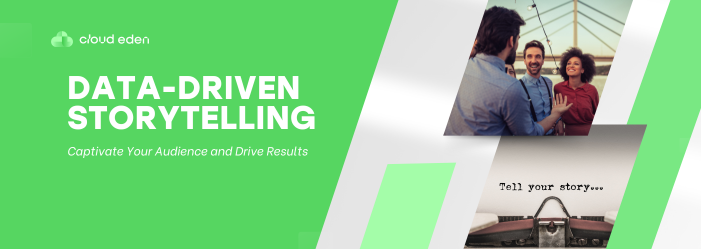Data-Driven Storytelling: Captivate Your Audience and Drive Results

In today's information age, consumers are bombarded with marketing messages. To stand out from the crowd, brands need to go beyond generic slogans and flashy visuals. They need to connect with their audience on a deeper level, and that's where data-driven storytelling comes in.
Data-driven storytelling is the art of using data to inform and enhance your marketing narratives. It's about taking cold, hard facts and transforming them into compelling stories that resonate with your audience and inspire them to take action.
Here's why data-driven storytelling is a must-have in your marketing arsenal:
- Cuts Through the Noise: People are bombarded with marketing messages daily. Data helps you tailor your story to address specific challenges and interests, making it more relevant and cutting through the noise.
- Builds Trust and Credibility: Data doesn't lie. By backing your claims with facts and figures, you establish yourself as a credible source and build trust with your audience.
- Evokes Emotions: Numbers can be powerful, but stories are what truly connect with people on an emotional level. Data-driven storytelling allows you to weave facts into a narrative that resonates with your audience's hopes, fears, and aspirations.
- Drives Action: A well-told story with data to support it can be incredibly persuasive. By highlighting the benefits of your product or service in a relatable way, you can motivate your audience to take the next step.
Now that you understand the power of data-driven storytelling, let's dive into how to craft compelling narratives that drive results:
1. Find the Story in the Data
Data is only the beginning. The key is to uncover the insights and trends that hide within the numbers. Ask yourself:
- What are the key challenges faced by your target audience?
- What are their pain points and aspirations?
- How can your product or service help them achieve their goals?
Look for patterns, correlations, and surprising findings in your data. These insights will form the foundation of your story.
2. Craft a Compelling Narrative
Once you have your insights, it's time to craft a narrative that resonates with your audience. Here are some storytelling elements to consider:
- Hero's Journey: This classic story structure positions your audience as the hero on a journey to overcome a challenge. Your product or service becomes the guide that helps them achieve their goal.
- Before-After-Bridge: Showcase the "before" state where your audience is struggling, then present the "after" state where your product or service solves their problems. The "bridge" is your solution.
- Data as Evidence: Weave data points seamlessly into your narrative to support your claims and add credibility. Use visuals like charts, graphs, and infographics to make the data easily digestible.
3. Know Your Audience
Tailor your story to the specific needs and interests of your target audience. Consider factors like demographics, pain points, and preferred communication styles. Speak their language and address their concerns directly.
4. Focus on the Human Element
Data is essential, but don't forget the human element. Use real-life examples, customer testimonials, and case studies to illustrate how your product or service makes a difference for people like your audience members.
5. Evoke Emotion
People connect with stories that evoke emotions. Tap into your audience's hopes, fears, and aspirations through your narrative. This emotional connection will make your story more memorable and persuasive.
6. Call to Action
Don't leave your audience hanging. End your story with a clear call to action, whether it's visiting your website, signing up for a free trial, or making a purchase.
Data-Driven Storytelling Examples in Action
Here are a few examples of how brands are using data-driven storytelling to achieve marketing success:
- Fitness Tracker Brand: Analyzes user data to identify common fitness challenges and creates content that offers solutions. A blog post could explore a trend like "Most Missed Steps Occur After Work" and provide tips for staying active throughout the day.
- E-commerce Platform: Uses customer purchase history to identify buying patterns and create personalized recommendations. An email campaign could highlight products frequently purchased together or suggest complementary items based on previous purchases.
- Non-profit Organization: Tracks the impact of donations and shares success stories with compelling visuals and data points. A video could showcase how donations helped build X number of schools, benefiting Y number of children.
Data-driven storytelling is not just a trend;
it's a marketing imperative. By leveraging data to craft compelling narratives, you can connect with your audience on a deeper level, build trust, and drive results.
Empowering Your Marketing with Data-Driven Storytelling Tools
Now that you understand the core principles of data-driven storytelling, let's explore some tools and techniques that can empower your marketing efforts:
Data Analytics Tools:
- Marketing Automation Platforms: These platforms collect and analyze customer data from various sources, providing valuable insights into customer behavior, preferences, and buying journeys.
- Web Analytics Tools: Tools like Google Analytics track website traffic, user behavior, and conversions. They reveal which content resonates with your audience and identify areas for improvement.
- Social Media Analytics Tools: Gain insights into audience demographics, engagement metrics, and trending topics on social media platforms.
Data Visualization Tools:
- Infographics: Make complex data sets easily digestible and visually appealing with infographics.
- Data Visualization Software: Tools like Tableau and Power BI allow you to create interactive charts, graphs, and dashboards that showcase trends and insights in a compelling way.
Content Creation Tools:
- Storytelling Frameworks: There are various storytelling frameworks available, such as the Hero's Journey or the Before-After-Bridge structure. These frameworks can help you craft a compelling narrative that resonates with your audience.
- Content Marketing Platforms: Platforms like HubSpot and Contentful allow you to plan, create, and manage your content across various channels, ensuring consistency and brand alignment for your data-driven stories.
Remember: Data-driven storytelling is an ongoing process. Here are some additional tips to ensure continuous improvement:
- Measure and Analyze: Track the performance of your data-driven content through analytics tools. See what resonates with your audience and adjust your approach accordingly.
- A/B Testing: Test different versions of your story, headlines, and visuals to see what generates the best results.
- Stay Updated: The data landscape is constantly evolving. Stay up-to-date on the latest trends and tools to get the most out of your data-driven storytelling efforts.
Conclusion:
Data-driven storytelling is a powerful tool that can transform your marketing from generic messages to captivating narratives that resonate with your audience and drive results. By following the tips and leveraging the tools mentioned above, you can create compelling content that cuts through the noise, builds trust, and ultimately motivates your audience to take action.
Remember, data is just one piece of the puzzle.
The true magic lies in combining data insights with the power of storytelling to create a lasting impact on your audience.
So, unleash your inner storyteller, embrace data as your guide, and watch your marketing soar to new heights.
Welcome To Our Blog





